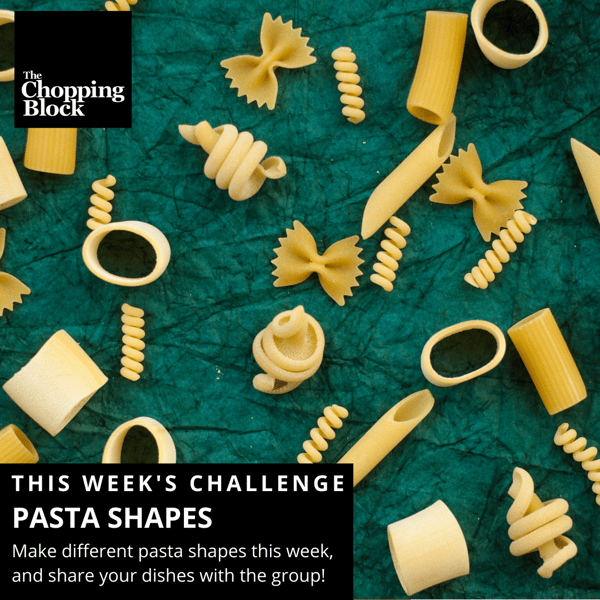Two-Ingredient Handmade Pasta

I’m not only a chef instructor at The Chopping Block, but I also develop the curriculum you see on our monthly calendars. It’s a big job that requires the help of my fellow colleagues, so once a month we put our heads together and brainstorm ideas for new and exciting class curriculum, and that’s how a lot of classes are born. These types of meetings are hands down my favorite because all we do is talk about food, and what’s not fun about that?
At the last meeting, we all talked about how great it would be to teach our students how to make an assortment of handmade pasta shapes that are impressive yet doable for the home cook, and that’s how our Virtual Cook Along: Pasta Shapes Workshop was created. In this class, we’ll be making two different pasta doughs and 5 different pasta shapes!
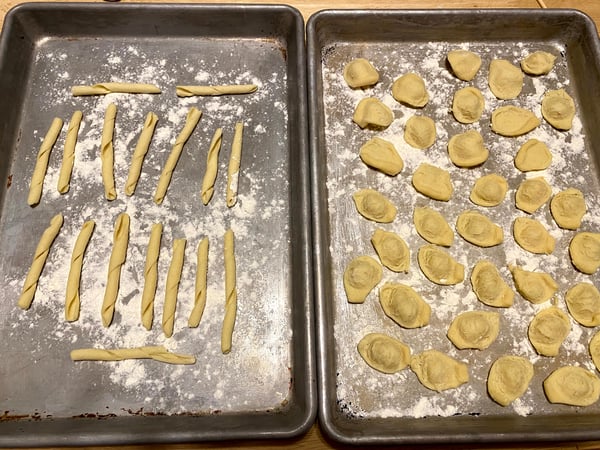 I have some experience with making fresh pasta, but I needed to do some research on how some of the pastas were traditionally shaped, which was a very enjoyable journey. Who else do you turn to when you have questions about making and shaping homemade pasta? An Italian grandmother! I don’t have an Italian grandmother (nor do I know one), so I did the next best thing and went to the Pasta Grannies YouTube channel. I could seriously watch the videos on this channel all day. It’s so relaxing and satisfying to watch the grannies with their decades of expertise and experience teach us step by step how to make beautiful food with love. It’s not only inspirational, but an excellent resource for those of us that want to learn more about traditional Italian food.
I have some experience with making fresh pasta, but I needed to do some research on how some of the pastas were traditionally shaped, which was a very enjoyable journey. Who else do you turn to when you have questions about making and shaping homemade pasta? An Italian grandmother! I don’t have an Italian grandmother (nor do I know one), so I did the next best thing and went to the Pasta Grannies YouTube channel. I could seriously watch the videos on this channel all day. It’s so relaxing and satisfying to watch the grannies with their decades of expertise and experience teach us step by step how to make beautiful food with love. It’s not only inspirational, but an excellent resource for those of us that want to learn more about traditional Italian food.
I took the knowledge I learned from the grannies to help create the curriculum for our class coming up in November, but I had to first put the methods to test in my own kitchen to ensure they were doable in a virtual class setting.
The first task was to make the semolina flour pasta dough. While some fresh pasta dough is made with eggs, semolina dough (without eggs) is preferred for various pasta shapes because its high gluten content helps hold the shape of the pasta when cooking. It also gives the pasta an excellent and rustic chew. Semolina is a type of flour, but it specifically comes from durum wheat and is more coarsely ground than all-purpose or “00” flour. It’s so coarsely ground that it can be easily confused with finely ground cornmeal, so be sure to read your labels.
Semolina Pasta Dough
Scroll down for a printable version of this recipe
Yield: 3-4 servings (about 3/4 pound of pasta)
Active time: 10 minutes
Start to finish: 30 minutes
1 1/2 cups semolina flour
1/2 cup water
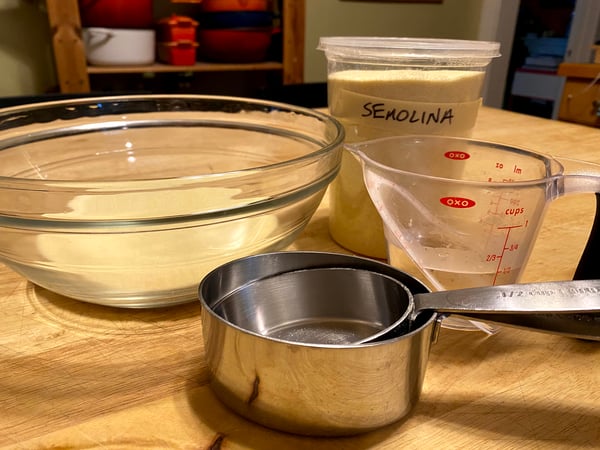
1. Place the semolina in a bowl, and form a well in the middle of the flour. Pour in 1/2 cup of water, and use a spoon to mix together the ingredients until you have a shaggy and crumbly dough.
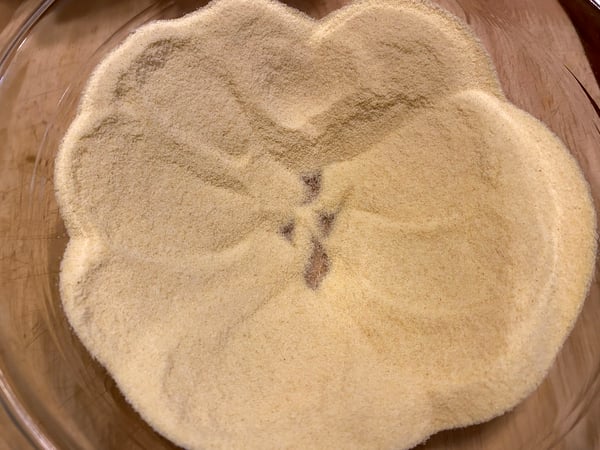
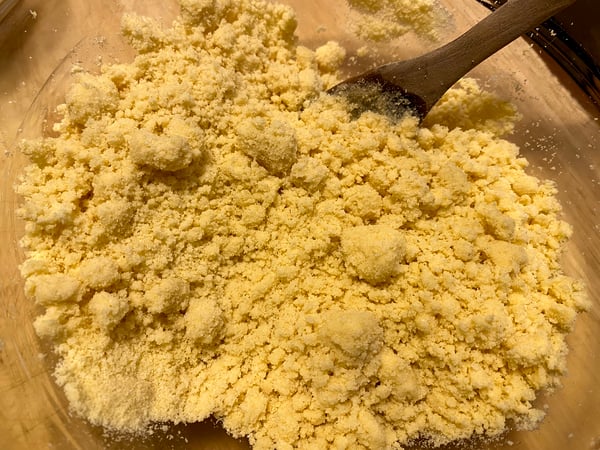
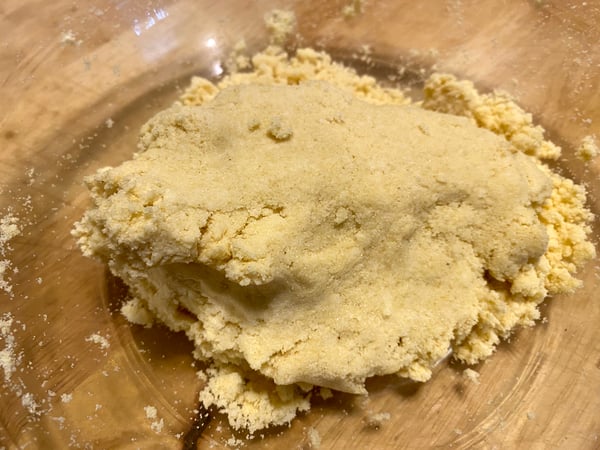
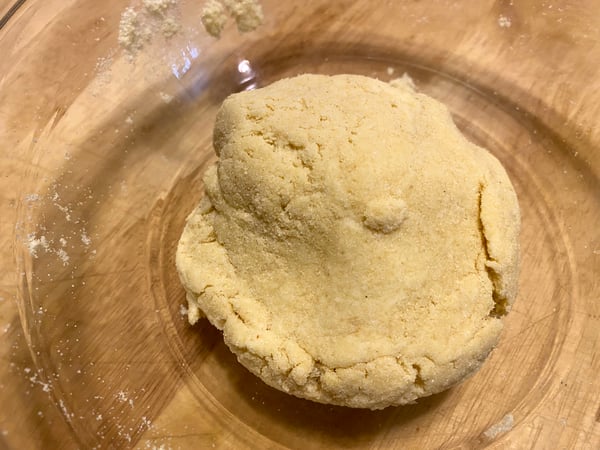 2. Using your hands, press together the dough until it forms a rough ball. Place the dough on your work surface and knead for 8 to 10 minutes, or until the dough is smooth and the semolina has been hydrated. The dough should be smooth, and firm yet elastic.
2. Using your hands, press together the dough until it forms a rough ball. Place the dough on your work surface and knead for 8 to 10 minutes, or until the dough is smooth and the semolina has been hydrated. The dough should be smooth, and firm yet elastic.
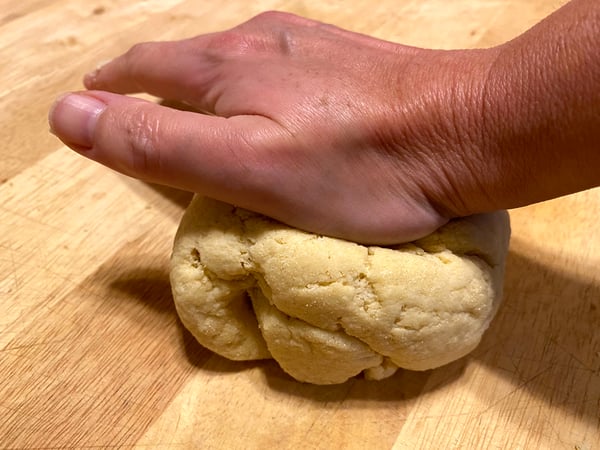 3. Wrap the dough tightly in plastic, and set it aside to rest for at least 20 minutes before shaping your pasta.
3. Wrap the dough tightly in plastic, and set it aside to rest for at least 20 minutes before shaping your pasta.
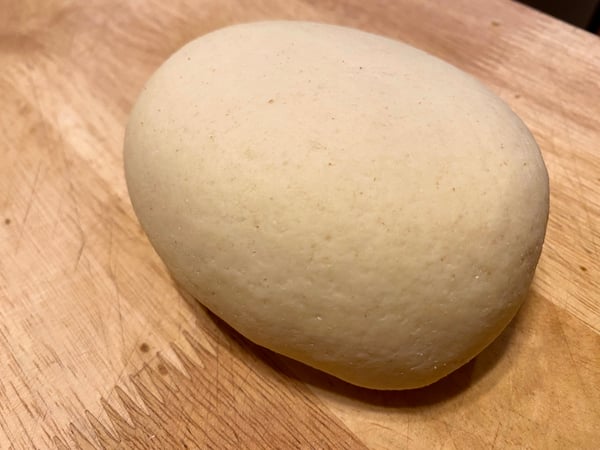 To make this two-ingredient pasta, all you have to do is mix together the semolina and water in a bowl (the grannies make a well on their countertop for this step, but I use a bowl because it’s less messy) until you have a crumbly and shaggy dough. Turn the dough out onto your countertop, and begin kneading. It will still look a bit crumbly around the edges at first, but keep in mind that semolina takes a bit longer to hydrate than all-purpose or “00” flour. After you knead the dough for 8 to 10 minutes, you’ll have a smooth and elastic dough that’s perfect for making a large variety of different pasta shapes, but I focused on two of the shapes we’ll be making in class called orecchiette and busiate.
To make this two-ingredient pasta, all you have to do is mix together the semolina and water in a bowl (the grannies make a well on their countertop for this step, but I use a bowl because it’s less messy) until you have a crumbly and shaggy dough. Turn the dough out onto your countertop, and begin kneading. It will still look a bit crumbly around the edges at first, but keep in mind that semolina takes a bit longer to hydrate than all-purpose or “00” flour. After you knead the dough for 8 to 10 minutes, you’ll have a smooth and elastic dough that’s perfect for making a large variety of different pasta shapes, but I focused on two of the shapes we’ll be making in class called orecchiette and busiate.
Orecchiette pasta literally translates to “little ears” because they look just like that! You take half of the dough and roll it into a 1/2-inch-thick rope. Form that rope you cut the dough into 1/4-inch pieces. Here’s a video my daughter took of me shaping the orecchiette.
Orecchiette
Yield: 2 servings
Active time: 35 minutes
Start to finish: 35 minutes
These little pasta shapes hail from Puglia in Southern Italy, and literally translate to “little ears.”
1/2 recipe Semolina Pasta Dough (recipe above)
1. Cut the dough in half, keeping the half you’re not working with wrapped in plastic.
2. Roll half of the dough into a 1/2-inch thick rope, and cut the rope into 1/4-inch wide pieces.
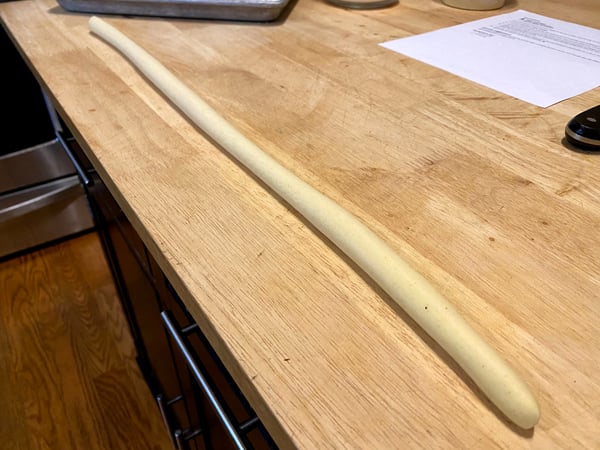
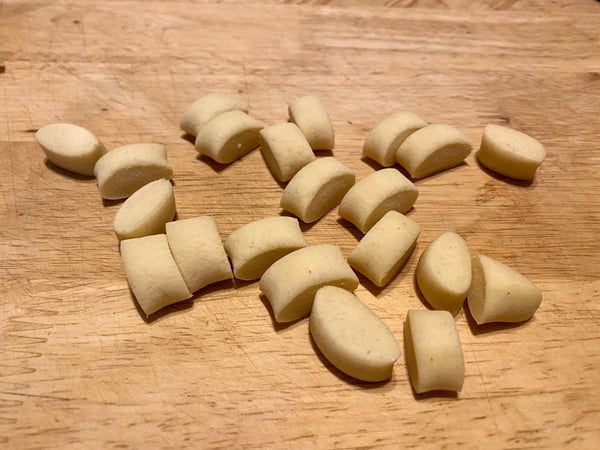 3. Using the curved side of a butter knife, press and stretch the piece of dough while pulling towards yourself to form a little cup. You can also do this using your thumb, but it doesn’t stretch the dough quite as much.
3. Using the curved side of a butter knife, press and stretch the piece of dough while pulling towards yourself to form a little cup. You can also do this using your thumb, but it doesn’t stretch the dough quite as much.
4. Turn the cup inside out to form “little ears”. Set the finished orecchiette on a flour-dusted sheet tray to dry for about 1 hour before boiling.
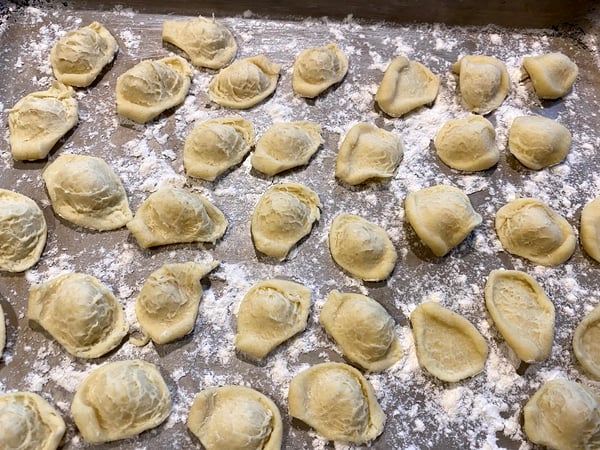 Serving suggestions: This pasta shape is most commonly served with a simple tomato sauce, but would also be delicious with arrabbiata or a cream sauce.
Serving suggestions: This pasta shape is most commonly served with a simple tomato sauce, but would also be delicious with arrabbiata or a cream sauce.
Busiate is not a pasta shape you hear about as much as some others, but it’s so fun to make! The pasta is named after the word “buso”, which is the stem of a local grass that’s used to shape the pasta. I used a bamboo skewer instead, and it worked like a charm! With the other half of the dough, roll it out just to flatten it to about 1/4 inch thick. Cut 1/2-inch-thick strips from the dough, and roll each strip into a 1/8-inch thin rope. From that rope, cut the dough into 1 1/2-to 2-inch lengths. Here’s another video my daughter took of me shaping the busiate.
Busiate
Yield: 2 servings
Active time: 45 minutes
Start to finish: 45 minutes
Busiate originate in Sicily, and are named after named after the buso, the stem of a local grass. The stem of the plant is then used to coil the dough around it giving this pasta it’s unique telephone cord shape. A bamboo skewer or knitting needle will also do the job.
1/2 recipe Semolina Pasta Dough (recipe above)
Bamboo skewer
1. Cut the dough in half, keeping the half you’re not working with wrapped in plastic.
2. Using a rolling pin, roll half the dough just to flatten it to about 1/2 inch and cut the piece of dough 1/2-inch strips.
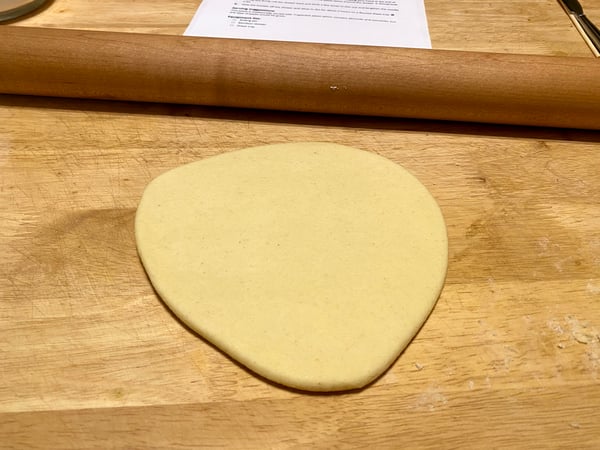
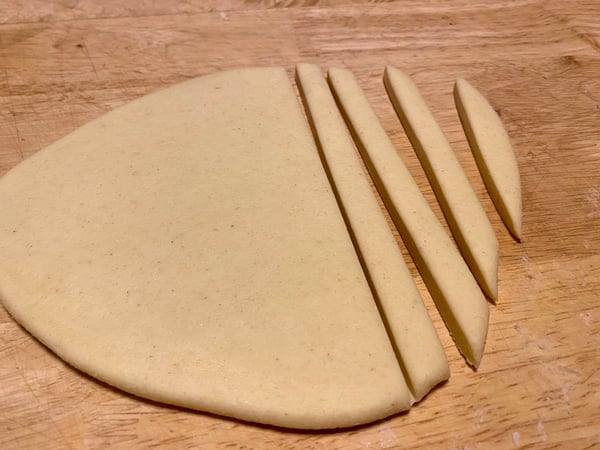 3. Using your hands, roll each strip of dough into a long, thin rope about 1/8-inch thick. Cut the rope into approximately 1 1/2- to 2-inch pieces.
3. Using your hands, roll each strip of dough into a long, thin rope about 1/8-inch thick. Cut the rope into approximately 1 1/2- to 2-inch pieces.
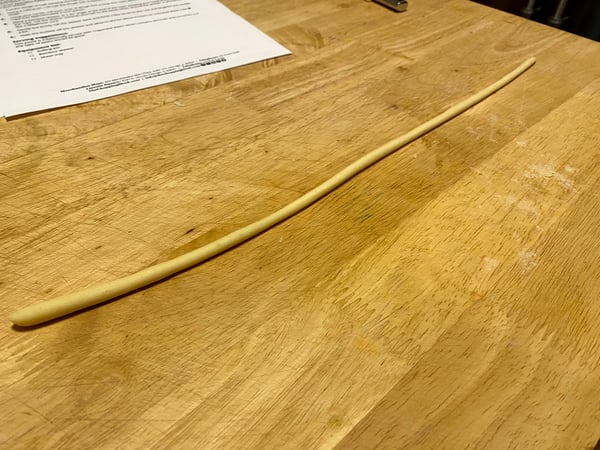
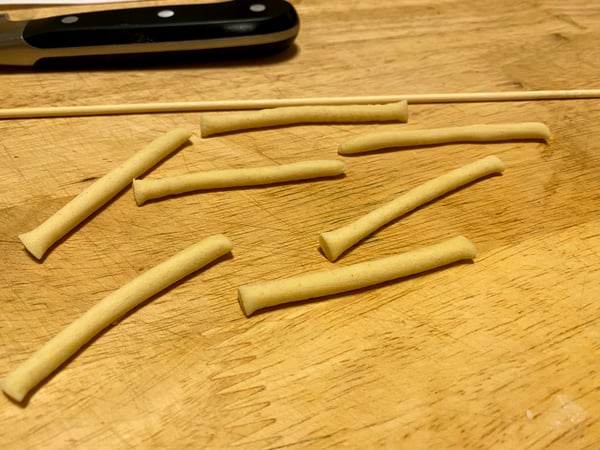 4. Place a bamboo skewer at a 45° angle at the end of the rope. Keeping your hand at the end of the rope, roll the skewer towards yourself so the pasta twists around the skewer. It should look like a telephone cord.
4. Place a bamboo skewer at a 45° angle at the end of the rope. Keeping your hand at the end of the rope, roll the skewer towards yourself so the pasta twists around the skewer. It should look like a telephone cord.
5. Gently but firmly roll the skewer back and forth a few times to thin out and lengthen the noodle a bit.
6. Slide the busiate off the skewer and allow to dry for about 2 hours on a floured sheet tray.
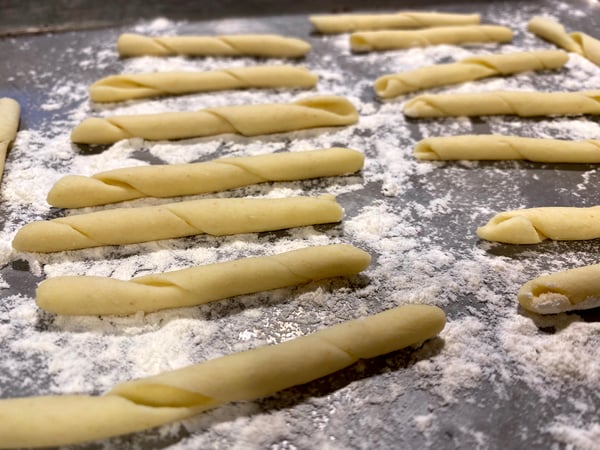 Serving suggestions: This pasta is traditionally served with Trapanese pesto which contains almonds and tomatoes, but any type of pesto would be great.
Serving suggestions: This pasta is traditionally served with Trapanese pesto which contains almonds and tomatoes, but any type of pesto would be great.
Because you want to make sure the pastas hold their shape when cooked, place the shaped pastas on a floured sheet tray and allow to dry for 1 1/2 to 2 hours. Overnight works great too, and because there’s no egg in the dough, you don’t need to worry about spoilage.
I was skeptical the pasta wouldn’t keep its shape when boiling, but it totally did! I simply tossed the cooked noodles with jarred tomato sauce to keep it easy, but you can toss the pasta with any sauce you like such as Ragú Bolognese, Pesto or Tomato Sauce.
This was such a fun, delicious and thoroughly enjoyable experiment. I’m not even close to having pasta grannie status, nor do I think I ever will, but making handmade shaped pasta is definitely something everyone can do in their own kitchen with minimal tools and ingredients.
Join us on Sunday, November 14th for our Virtual Cook Along: Pasta Shapes Workshop as we have fun making the pasta shapes mentioned above along with Cavatelli, Farfalle and Tortellini!
Pasta shapes are this weeks' challenge for our private Facebook group members. Give these two shapes a try this week and share your creations with other home cooks.
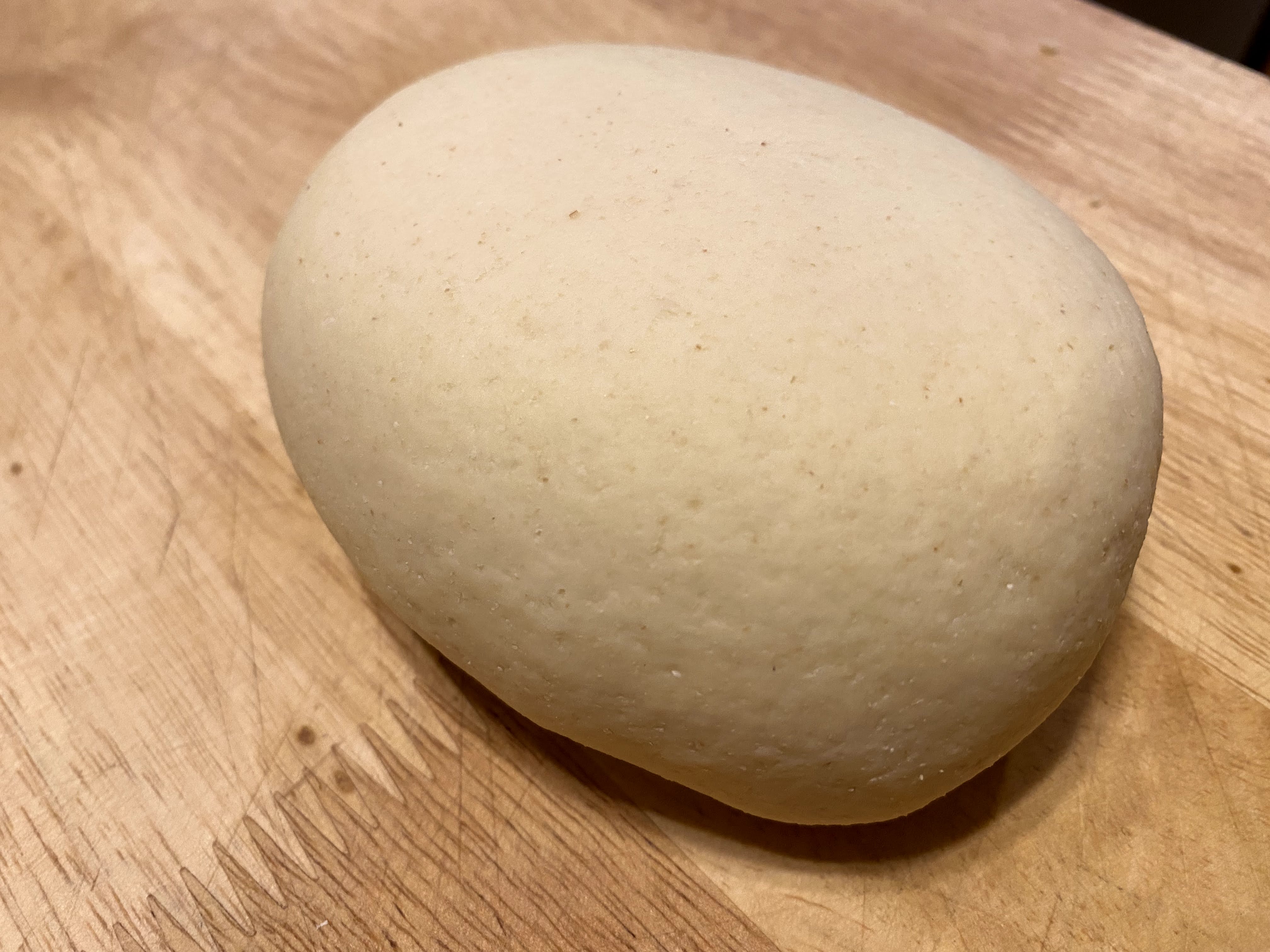
Semolina Pasta Dough
Ingredients
- 1 1/2 cups semolina flour
- 1/2 cup water
Instructions
- Place the semolina in a bowl, and form a well in the middle of the flour. Pour in 1/2 cup of water, and use a spoon to mix together the ingredients until you have a shaggy and crumbly dough.
- Using your hands, press together the dough until it forms a rough ball. Place the dough on your work surface and knead for 8 to 10 minutes, or until the dough is smooth and the semolina has been hydrated. The dough should be smooth, and firm yet elastic.
- Wrap the dough tightly in plastic, and set it aside to rest for at least 20 minutes before shaping your pasta.

